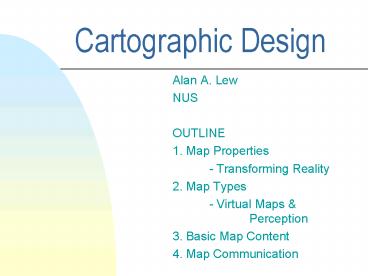Cartographic Design - PowerPoint PPT Presentation
1 / 16
Title: Cartographic Design
1
Cartographic Design
- Alan A. Lew
- NUS
- OUTLINE
- 1. Map Properties
- - Transforming Reality
- 2. Map Types
- - Virtual Maps Perception
- 3. Basic Map Content
- 4. Map Communication
2
1. Map Properties
- 1.1. - Maps Show Locations
- Distance
- Direction
- Adjacency
- Insideness / Outsideness
- Patterns
- Connectivity/Networks
- 1.2. - Attributes/Characteristics of Places
- Place names
- Population, Elevation, etc.
3
1.3. - Scaling of Reality
- smaller than area portrayed
- Scale (3 types)
- 1.3.1. - Representative Fraction
- 1.3.2. - Text Scale (Word Statement)
- 1.3.3. - Graphic Scale
- Large Scale/Small Scale
- Large 150 000 or greater (smaller number)
- Small 1250 000 or smaller (bigger number)
- Readings NOTE Do Not Need to Know the US
Customary Units of Measurement
4
1.4. - Transformation of Reality
- Curved earth on a Flat surface
- Larger Area More Distortion
- 1.4.1. Projections
- No Perfect Projection
- Equal Area, Equidistant, Conformal (shape)
- 1.4.2. Coordinate Grid Systems
- maintain location information on distorted
surface - Latitude/Longitude
- Universal Transverse Mercator
- Local Plane Coordinate Systems
5
1.5. - Generalising Reality
- 1.5.1. SELECTION
- what to Include and what to Ignore
- 1.5.2. SIMPLIFICATION
- of shapes and lines - made less complex
- 1.5.3. COMBINATION
- of several similar objects grouped into one
- 1.5.4. LOCATION SHIFT
- if things are too close together
- 1.5.5. SIZE EXAGERATIONS
- for things that are too small
- Scale is Independent of Generalisation
6
1.5. (Generalizing cont.) - Symbol Types
- 1.5.6. Points
- Distribution
- Shape (geometric, pictoral)
- Size, Color (type, quantity)
- 1.5.7. Lines
- Qualitative Line pattern (geometric, pictoral)
- Quantitative Size, Thickness, Color
- 1.5.8. Polygon/Area
- Qalitative (exists or not)
- Quantitative (degree/value shown by Pattern or
Color)
7
2. Map Function Type
- 2.1. FUNCTIONAL USES
- Planimetric Maps - no relief
- Oultine / Base maps
- Cadastral/Property Maps
- Topographic Maps - show relief
- Engineering Plans
- Road Maps Charts - navigation
- Thematic Maps
- Dot Maps
- Choropleth Maps - shade/colour
- Cartograms
8
2.2. - Virtual Maps
- Virtual can be made real
- Real Hard copy maps
- 2.2.1 - Computer screen maps
- 2.2.2 - Remote sensing
- Imagery
- Aerial Photographs
- Vertical, Oblique, Orthogonal
- Satellite Images
- Misc. Data sources
- handwritten notes
- survey measurements
9
2.2.3. Mental maps
- Kevin Lynch, Image of the City (1961)
- 1 - Boundaries
- 2 - Barriers
- 3 - Routes
- 4 - Landmarks
- which people might use to orient themselves
within the city - 5 - Activity Centres
- 6 - Regions / Areas / Neighbourhoods
- Behavioural space / maps
- Images / opinions of places and the world
- Marketing applications
10
2.3. Approach
- 2.3.1. Map Accuracy
- Map Geometry Geomatics Geodesy
- Surveying, Civil Engineering, Utilities,
Infrastructure, Property Development - 2.3.2. Map Technology
- Technological Effiency/GIS
- Urban Planning (general) and Natural Resource
Management - 2.3.3. Map Communication and Design
- focus on Perception
- Color, Balance, Orientation, Pattern, Form
- Graphics Designers and Publishers
11
3. Basic Map Contents
- 3.1. Every Map Should Have
- Title - and Purpose, if Thematic
- North Arrow
- Scale Indicator
- Legend
- 3.2. Recommended Contents
- Grid/Location system
- Date
- Cartographers Name
- Projection
12
4. Map Communication Model
- Map Author --gt Intended Map Message --gt Map
Technique (the MAP) --gt Map Reader --gt Map
Message Received - Goal
- INTENDED MESSAGE RECEIVED MESSAGE
- Intended Message
- What Is INCLUDED and what is NOT INCLUDED
- Biggest Problem - Trying to Include TOO MUCH
- Map Technique
- How Best to Present the Information
- Map Reader - Perception and Cognition
13
Noise
- distortions and unwanted messages
- 4.1 - Map Author Noise
- INACCURATE or INCOMPLETE DATA
- UNCLEAR or UNFOCUSSED about MESSAGE
- cannot decide what to keep and leave out
- unfamiliar with map limitations
- poorly communicates intent to Map Maker
- 4.2 - Map Maker / Technique Noise
- POOR DESIGN
- Cluttered/Excess Data, Unclear, Poor Layout
- Printing Process problems
14
4.3. - Map Reader
- PERCEPTUAL NOISE
- 4.3.1. Visual Perception
- biological - preceeds Cognition
- Apparent relative size of objects
- tend to visually Underestimate Large Dot Sizes
compared to Small - Figure-Ground Contrast
- cannot see features if they do not Stand Out from
the background - Tonal/Color Contrast
- poor contrast (BW) or too many colors
- Too Many Symbols
15
4.3. Map Reader (cont.)
- 4.3.2. Attitude
- toward Maps in General
- can be Overcome through map Design
- toward the Map being Viewed
- Interesting, Uninteresting or even Repelled
- 4.3.3. Cognition
- Ability to Decode a Map
- Increases with
- Intelligence or Map Knowledge
- Experience with Similar Maps
- Readers Understanding from the Map can EXCEED
that of the Map Author
16
SUMMARY
- 1. Map Properties
- Location, Place Characteristics
- Scaling, Transforming, Generalizing (Symbols)
- 2. Map Types
- Functional Uses
- Virtual Maps Perception
- Approach
- 3. Basic Map Contents
- 4. Map Communication
- Author, Cartographer, Reader































